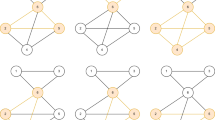Abstract
In this paper we present a heuristic based steady-state genetic algorithm for the maximum clique problem. The steady-state genetic algorithm generates cliques, which are then extended into maximal cliques by the heuristic. We compare our algorithm with three best evolutionary approaches and the overall best approach, which is non-evolutionary, for the maximum clique problem and find that our algorithm outperforms all the three evolutionary approaches in terms of best and average clique sizes found on majority of DIMACS benchmark instances. However, the obtained results are much inferior to those obtained with the best approach for the maximum clique problem.
Similar content being viewed by others
References
Abello, J., P.M. Pardalos, and M.G.C. Resende. (2000). “On Maximum Clique Problem in Very Large Graphs.” DIMACS Series in Discrete Mathematics and Theoretical Computer Science 50, 119–130.
Aggarwal, C.C., J.B. Orlin, and R.P. Tai. (1997). “An Optimized Crossover for Maximum Independent Set.”Operations Research 45, 226–234.
Balas, E. and W. Niehaus. (1996). “Finding Large Cliques in Arbitrary Graphs by Bipartite Matching.” DIMACS Series in Discrete Mathematics and Computer Science 26, 29–51.
Balas, E. and W. Niehaus. (1998). “Optimized Crossover-Based Genetic Algorithms for the Maximum Cardinality and Maximum Weight Clique Problem.” Journal of Heuristics 4, 107–122.
Battiti, R. and M. Protasi. (2001). “Reactive Local Search for the Maximum Clique Problem.” Algorithmica 29 (4), 610–637.
Beasley, J.E. and P.C. Chu. (1996). ”A Genetic Algorithm for the Set Covering Problem.” European Journal of Operation Research 94 (2), 394–404.
Biggs, N. (1990). ”Some Heuristics for Graph Coloring.” R. Nelson and R.J. Wilson (eds.), In Graph Colourings pp. 87–96, NY: Longman.
Bomze, I.M., M. Budinich, P. M. Pardalos and M. Pelilo. (1999). “The Maximum Clique Problem.” Handbook of Combinatorial Optimization, 4, Boston, MA: Kluwer Academic Publishers.
Busygin, S. (2002). “A New Trust Region Technique for the Maximum Weight Clique Problem.” submitted to the special issue of Discrete and Applied Mathematics on Combinatorial Optimization.
Carraghan, R. and P.M. Pardalos. (1990). “An Exact Algorithm for the Maximum Clique Problem.” Operation. Research Letters 9, 375–382.
Davis, L. (1991). Handbook of Genetic Algorithms, New York: Van Nostrand Reinhold.
Dorigo, M. and T. Stutzle. (2004). Ant Colony Optimization.MIT Press/Bradford Books.
Fenet, S. and C. Solnon, (2003). “Searching for Maximum Clique with Ant Colony Optimization.” Applications of Evolutionary Computing (EvoCOP 2003), LNCS 2611, Springer-Verlag, pp. 236–246.
Feo, T.A., M.G.C. Resende, and S.M. Smith. (1994). “A Greedy Randomized Adaptive Search Procedure for Maximum Independent Set.” Operations Research 46(5), 860–878.
Garey, M.R. and D.S. Johnson. (1979). Computers and Intractability: A Guide to the Theory of NP-Completeness. San Francisco: W. H. Freeman.
Grosso, A., M. Locatelli, and F. Della Croce. (2004). “Combining Swaps and Node Weights in an Adaptive Greedy Approach for the Maximum Clique Problem.” Journal of Heuristics 10, 135–152.
Homer, S. and M. Peinado. (1996). ”On the Performance of Polynomial Time Clique Approximation Algorithms on Very Large Graphs” Clique, Coloring and Satisfiability, Second DIMACS Implementation Challenge, pp. 221–242 D. S. Johnson and M. A. Trick (eds.).
Jagota, A. and L.A. Sanchis. (2001). “Adaptive, Restart, Randomized Greedy Heuristics for Maximum Clique.” Journal of Heuristics 7, 565–585.
Johnson, D.S. (1974). “Approximation Algorithms for Combinatorial Problems.” Journal of Computer Science 9, 256–278.
Khot, S. (2001). “Improved Inapproximability Results for Maxclique, Chromatic Number and Approximate Graph Coloring.” In Proceedings of 42nd Annual IEEE Symposium on Foundations of Computer Science (FOCS), pp. 600–609.
Marchiori, E. (2002). “Genetic, Iterated and Multistart Local Search for the Maximum Clique Problem.” Applications of Evolutionary Computing (EvoCOP 2002), LNCS 2279, Springer-Verlag, pp. 112–121.
Massaro, A., M. Pellilo and I. M. Bomze. (2002). “A Complementary Pivoting Approach to the Maximum Weight Clique Problem.” SIAM Journal of Optimization12, 928–948.
Motzkin, T.S. and E.G. Strauss. (1965). “Maxima for Graphs and a New Proof of Theorem of Turan.” Canadian Journal of Mathematics17, 533–540.
Resende, M.G.C., T.A. Feo, and S.H. Smith. (1998). “Algorithm 786: FORTRAN Subroutines for Approximate Solution of the Maximum Independent Set Problem Using GRASP.” ACM Transactions on Mathematical Software24, 386–394.
Soriano, P. and M. Gendreau. (1996). “Tabu Search Algorithms for the Maximum Clique.” Clique, Coloring and Satisfiability, Second DIMACS Implementation Challenge, D.S. Johnson and M.A. Trick (eds.), pp. 221–242.
Author information
Authors and Affiliations
Corresponding author
Rights and permissions
About this article
Cite this article
Singh, A., Gupta, A.K. A hybrid heuristic for the maximum clique problem. J Heuristics 12, 5–22 (2006). https://doi.org/10.1007/s10732-006-3750-x
Received:
Accepted:
Issue Date:
DOI: https://doi.org/10.1007/s10732-006-3750-x




